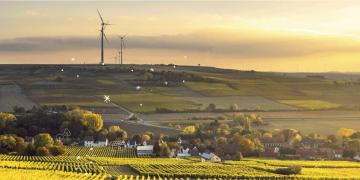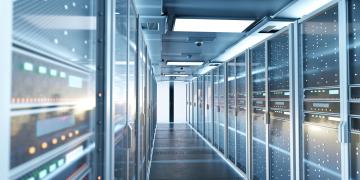Trending Forward: Powering the future - Building resilient electricity grids
Investing Insights from the Sustainable Equities Team
In Brief
- Increased demand and infrastructure challenges highlight the need for substantial investment and modernization of our aging electricity grid networks to support rising electrification and the energy transition.
- Numerous investment opportunities are emerging due to the expansion of the electricity grid across the U.S. and Europe, fueled by the growing demand for energy.
- Utilities that invest in upgrading their networks, along with companies that supply electrical equipment and transmission cables, are well-positioned to benefit.
Environment
Climate Change
We invest in companies with meaningful exposure to economic tailwinds from long-term transitions that are affecting the global economy: demographics, environmental, technological and governance. The environmental transition includes climate change, natural resource constraints, and biodiversity loss which are driving global efforts to transition to a more resilient economy, creating demand for renewable energy, clean transportation, circular economy, and sustainable agriculture.
Electricity networks are the backbone of our energy system and will play a crucial role in the energy transition. As we shift towards renewable energy sources and increased electrification, networks will be tested. With electricity demand expected to surge and the rise of renewable power generation, our aging grid infrastructure presents significant challenges. Substantial investment and innovative solutions will be necessary to ensure power grids can support the electrification of our energy system and rising demand. For years, electricity consumption in the U.S. has been stable and even declining in Europe due to increased efficiency. However, demand is now accelerating due to electrification, the growing integration of renewable power, electric vehicles, industrial production, the rising use of air conditioning globally, and the expansion of data centers worldwide.
Electricity is set to increase to over 50% of the total final energy consumption by 2050 after remaining below 20% for the past two decades1 .
The energy transition will put additional pressure on electricity networks because of the integration of intermittent renewable energy sources. Given the current political context, secure and resilient electricity sources are a priority. Preparing electricity networks for the future presents strong investment opportunities driven by the need to modernize infrastructure to accommodate rising power demand and variability. Addressing these challenges is not only necessary for grid reliability but also vital for facilitating innovation and advancing the energy transition.
Investment Opportunities and Challenges
From grid modernization to the decarbonization and electrification of our society, there are numerous investment opportunities across the electricity network value chain including electricity production, transmission, and distribution. However, lengthy planning and approval processes for electricity networks pose some challenges.
Regulatory frameworks are expected to evolve, though their effectiveness will depend on individual countries’ policies that support and facilitate grid development and investment. In the UK, Germany, and the U.S., the period from identifying the need for a new transmission line to its connection to the grid typically spans 12 to 14 years2 . Most of this time is spent securing planning approvals and permits rather than on construction, often due to local opposition and regulatory uncertainty. Regulations that promote infrastructure investment while maintaining affordability will be crucial, with policymakers playing a key role in establishing regulatory frameworks and subsidies that make investing in electricity networks a viable investment opportunity to facilitate grid expansion.
Investment and innovation in electricity networks must respond to the accelerating pressure from the integration of renewable energy sources into the grid, which adds a layer of complexity. Renewable energy technologies generate intermittent electricity and are often located far from demand centers like cities. Infrastructure improvements are critical to using renewable resources to their full potential and help to address power demand.
The rise of renewables, combined with an aging grid with limited interconnections, has created situations where renewables’ output exceeds grid capacity, resulting in electricity prices dropping to zero, and/or grid operators having to curtail renewable output and procure expensive and CO2-intensive backup generation. This further highlights the need for grid infrastructure upgrades to align with the energy supply and for a more robust and efficient energy system that is ready to embrace and advance renewable energy.
Over 3,000 GW of renewable power projects are currently awaiting grid connections in the U.S.—five times the capacity added in 20223 . This number is even higher worldwide.
In Germany, the congestion cost over €4bn in 2022 with 8TWh (terawatt-hour) of renewable power wasted (equivalent to a large nuclear plant running all year)4 .
The anticipated rise in capital expenditure is expected to translate into substantial earnings growth, particularly for those entities willing to invest in upgrading power generation, transmission, and distribution systems to accommodate the increased load and complexity. The companies that are enabling these utility companies to make these upgrades, including electrical equipment and transmission cable companies, are also poised to benefit.
Key Enablers
- National Grid operates transmission and distribution electricity networks across the UK and the U.S. In response to the urgent need for infrastructure improvement, National Grid has one of the most ambitious strategic plans in the space and is planning to invest £60bn over 2024-2029, nearly doubling the capital expenditure (capex) spent over the last five-year period5 .
- Iberdrola is one of the largest global integrated utilities. 60% of capex is focused on electricity networks, which is boosted by a favorable regulatory environment and Net Zero targets. Iberdrola announced investments through 2026, including €21.5bn in grid infrastructures and €10.5bn in renewables, aiming for over 100 GW of installed capacity by 2027, with approximately 80 GW from renewable sources5 .
- NextEra Energy (NEE) is an electric power and energy infrastructure company in North America focused on investing in generation, transmission, and distribution facilities. NEE is one of the world's largest generators of renewable energy from wind and solar, as well as a leader in battery storage.
- EDP is the largest utility in Portugal and fourth largest integrated utility in Spain and has a strong presence in Brazil and the U.S. Over 2024-2026, EDP will invest €17bn, including 80% in renewables, clients, and energy management, and 20% in networks5 . E.ON is one of Europe’s largest distribution system operators with around 1.6 million kilometers of electricity and gas grids in nine European countries. >15% of all renewable assets in Europe are connected to the E.ON grid5 .
Implications for Other Industries
TRANSMISSION AND INTERCONNECTION CABLES
- Nexans is the world's second-largest manufacturer of cables and cabling systems. The group is mainly present in Europe but has a global presence. The group is active in high-voltage, medium-voltage, and low-voltage activities.
ELECTRICAL EQUIPMENT
- Siemens is a German industrial technology company with world-class electrification and automation assets. Its Smart Infrastructure division offers medium- and low-voltage products for buildings, grids, and infrastructure, and is well positioned to benefit from the electrification megatrend, grid modernization, and data centers. Hubbell is a manufacturer of electrical products and utility solutions.
- Hubbell manufactures and sells electrical products and solutions for utilities that are key for grid modernization, electrification, and renewable energy production.
- Johnson Controls International is a manufacturer and installer of HVAC equipment, industrial refrigeration, building controls, security systems, and fire detection and suppression systems. The company contributes to energy efficiency in buildings and data center expansion.
Risk Management & Responsible Practices
Electricity networks play a crucial role in the energy transition. However, the current limitations of the grid are inhibiting our progress toward net-zero targets. Electrification and infrastructure upgrades are important to move forward the net-zero agenda, and renewable energy will be vital for meeting the growing demand for electricity.
Physical climate risks such as wildfires, extreme heat, and flooding can lead to operational disruptions and liability concerns for electricity networks. Mitigating these risks requires integrating climate considerations into the planning phase and investing in resilience and adaptation strategies. Electricity companies also face emission challenges especially due to sulfur hexafluoride (SF6), a gas used for insulation in electrical equipment, which poses significant environmental risks due to its high global warming potential and long atmospheric lifetime. Even minor leaks can contribute to substantial carbon emissions. Transparency around SF6 emissions and the development of greener alternatives are crucial; for example, the UK's National Grid aims to eliminate SF6 by 2050 and invest in greener alternatives.
Biodiversity risks also present significant financial challenges for electricity networks due to their dependence on ecosystem services and land use impacts, potentially leading to regulatory penalties and project delays; therefore, identifying biodiversity hotspots, integrating biodiversity metrics into operations, collaborating with regulators on conservation goals, and implementing effective risk management strategies are essential. At Mirova, we account for these types of potentially material risks when analyzing companies offering solutions for electricity infrastructure to ensure they are compatible with our long-term investment approach.
1 International Energy Agency. (2025). Tracking Electricity.
2 Delivering the Energy Transition Will Come Down to the Wires" BCG study February 2025.
3 International Energy Agency. (2023). Electricity grids and secure energy transitions.
4 International Energy Agency.
5 Source: Mirova Research.
The securities mentioned above are shown for illustrative purpose only and should not be considered as a recommendation or a solicitation to buy or sell. The information provided reflects MIROVA’s opinion / the situation as of the date of this document and is subject to change without notice.

Position Paper

The team's quarterly round-up Fixed Income

Investing Insights from the Sustainable Equity Team



